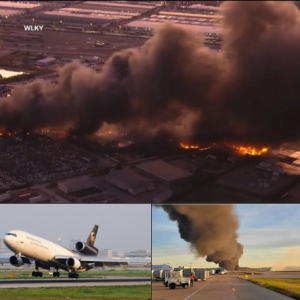
Here’s a detailed look at the recent incident involving a Boeing passenger aircraft whose engine erupted into flames — examining what happened, how the emergency landing unfolded, what the implications are for aviation safety, and what remains under investigation.
What happened
On Saturday, August 16, 2025, Condor Airlines Flight DE 3665 — a Boeing 757-300 departing from Corfu (Ioannis Kapodistrias) Airport (Greece) bound for Düsseldorf Airport in Germany — encountered a serious in-flight engine malfunction. www.ndtv.com+2Interesting Engineering+2
At around 36,000 ft altitude the aircraft’s right engine exhibited an airflow disturbance in the turbine, according to the airline. People.com+1
Simultaneously, social media footage showed visible flames or sparks emanating from the engine area or its rear cowling. Interesting Engineering+1
The crew declared an emergency and diverted the aircraft to Brindisi Airport in southern Italy, where it landed safely about 40 minutes after takeoff. All 273 passengers and 8 crew were reported safe, though some had to overnight in the airport due to insufficient accommodations. People.com
The passenger experience & imagery
Videos circulating online captured the dramatic moment: the plane climbing after take-off when flames suddenly appeared out the right engine area. One passenger said they sent a “goodbye text” because they believed the worst was happening. LADbible+1
Another described the aircraft’s power briefly dropping, then the decision to turn back. People.com
Such first-person accounts serve to underscore how frightening a seemingly routine flight can become when the unexpected happens.
Immediate response by the airline and authorities
Condor issued a statement saying the diversion was due to a “parameter reading outside the normal range” caused by disturbance in air-flow to the engine. People.com+1
The airline assured that at no time were passengers or crew in danger, and that safety was the top priority. People.com
Authorities reportedly have begun an investigation into the cause of the engine malfunction; initial reporting suggests a bird‐strike cannot yet be ruled out. Interesting Engineering+1
Why this kind of incident matters
-
Engine fires in flight are rare but serious. Modern commercial aircraft are certified to tolerate single‐engine failures, but visible flames add complexity and urgency to the decision-making in the cockpit.
-
The model involved. The Boeing 757 is an older air-frame (though still widely used). The incident may raise questions about maintenance, engine health, and lifecycle of older aircraft. www.ndtv.com
-
Passenger safety and confidence. When videos of a plane with flames reach social media, public trust is tested. Aviation safety hinges not just on actual risk mitigation but also on perception and communication.
-
Regulatory implications. Investigations may uncover contributing factors (bird strike, engine wear, airflow disruption, maintenance lapses) that could prompt regulatory review, air‐worthiness directives, or changes in airline procedures.
What we still don’t know and what to watch for
-
The exact cause of the flames hasn’t yet been confirmed: while disturbing airflow was cited, and a bird strike is suspected, no final conclusion has been publicly released.
-
Whether the engine experienced an uncontained failure (i.e., debris exiting the casing) or a contained fire remains to be clarified — this matters greatly for assessing risk to the fuselage or control systems.
-
Maintenance records of the aircraft and its engine (including time since last overhaul, history of bird‐strike reports, oil leaks or turbine damage) are not yet available.
-
Whether Boeing (or the engine manufacturer) will issue or has already issued technical service bulletins related to this model/engine type in light of this incident.
-
The broader statistical trend: this is one of multiple recent incidents of Boeing‐powered aircraft experiencing engine fire/flare events — regulators and the public will be watching to see if this turns into a pattern.
Key lessons emerging so far
-
Crew training and readiness matter: The successful diversion and safe landing demonstrate that pilots and crew responded appropriately under pressure — declaring emergency quickly, diverting to nearest suitable airport, safely landing without injuries.
-
Early detection is crucial: The trigger appears to have been abnormal readings in engine parameters, enabling the crew to act before escalation.
-
Age of fleet matters: While air frames can be safely operated for decades, the older the aircraft and engine family, the more reliant the operation is on rigorous maintenance, inspections for fatigue, ingestion damage, etc.
-
Communication with passengers: One of the more visible consequences of the incident is passenger fear. Airlines must manage not only the technical side of safety but also the psychological side — reassuring passengers, providing clear information, and arranging follow-on travel.
-
Importance of event investigation: Every incident of fire or engine malfunction adds to the database of risk, and investigations feed into improved design, maintenance regimes, and operational protocols.
Broader industry context
This isn’t the only recent engine‐fire/diversion incident involving a Boeing aircraft. For example, a Delta Air Lines Boeing 767-400 flight (#446) departing from Los Angeles International Airport had flames erupt from its left engine shortly after takeoff, forcing a return to base. Travel Noire+2Business Standard+2
Incidents like this raise questions about clustering of engine events, oversight of aging engine fleets, and lessons learned from past uncontained failures such as British Airways Flight 2276 (2015) where a Boeing 777 suffered a left‐engine uncontained failure during takeoff from Las Vegas. Wikipedia
Regulators such as the Federal Aviation Administration (FAA) and corresponding European bodies track flame/out-of-engine‐cowling events as precursors to more serious failures and may issue air-worthiness actions proactively based on investigation findings.
What passengers should know
-
Incidents like these are extremely rare relative to the number of flights undertaken globally every day.
-
Modern twin‐engine commercial jets (including the Boeing 757) are certified to operate safely on one engine and are designed with multiple redundant safety systems.
-
If you ever see unusual flames, hear abnormal sounds, or experience sudden descent/turn-back announcements during flight, remember that crew are trained for such scenarios and that declaring an emergency doesn’t mean loss of control — it means taking the safest and fastest route to land.
-
For frequent flyers, noticing the age of the aircraft can be interesting, but airlines and regulators monitor air-worthiness, maintenance history, and fleet renewal continuously — age alone is not a sole risk indicator.
-
Communication: If in doubt, asking crew for official updates can help reduce anxiety; follow their instructions promptly.
Final thoughts
The emergency landing of the Condor Boeing 757 due to engine flame-out is a stark reminder of both the inherent risks in aviation and the high standards of safety systems in place to manage them. While the incident is unsettling for passengers and the public, the fact that the aircraft landed safely without injury speaks to the strength of training, design, and operational discipline in commercial flight.
What remains critical now is the thorough investigation — identifying root causes, feeding findings into preventive actions, and ensuring that this incident is leveraged to strengthen safety margins even further. Aviation is a zero-tolerance profession when it comes to unexpected fires or engine failures — each incident becomes an opportunity to learn, adapt, and improve.

